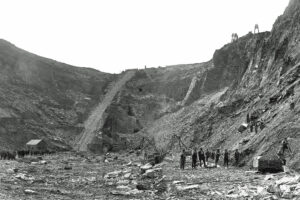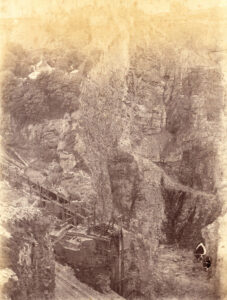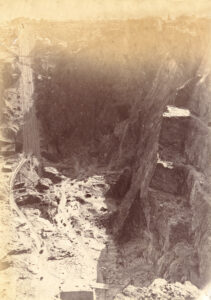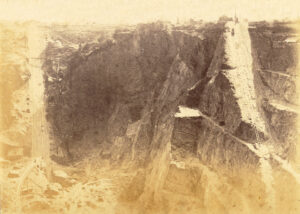 Delabole Slate Quarry
Delabole Slate Quarry
Alan Murton is in east Cornwall and brings us the story of a Cornish icon – the Delabole Slate Quarry. Most of us have heard of it, some have seen it, but a pound to a penny there’s something new to learn from this graphic article.
Standing at dawn with thousands of others on the edge of the Grand Canyon a cynical tourist asked: “Who dug this hole?” Nearer to home, there’s a hole 425 feet deep and over a mile and a half around. So, who dug this one?
Generations of Cornishmen, that’s who!
 Delabole Slate Quarry (Photo: Harry Rich – courtesy Malcolm Mc Carthy))
Delabole Slate Quarry (Photo: Harry Rich – courtesy Malcolm Mc Carthy))
The Delabole Slate Quarry is just over a mile from the Atlantic Coast, in the heart of King Arthur country. It is the oldest and largest slate quarry in the country and its products have been in demand in the building industry for 600 years. The unmistakeable blue-grey slate is another of the Duchy’s natural resources, a result of thousands of years of geological activity, finally pushed into place by the development of the granite mass of Bodmin Moor and, unlike the tin and copper that was once Cornwall’s pride, there’s probably enough for another 600 years.
It was in 1314 that Delabole slate was hauled to Winchester to roof the Castle there – the first recorded order for Cornish slate and thought to be the longest surviving example of its use. Durability is the unique benefit of Delabole slate as a roofing material – it is not uncommon to find roofs known to have been built 300 years earlier nor for those same slates to be re-used when the timbers that support them have to be stripped out and replaced.
Cornishmen in exile remember the blue slate roofs they could see from their windows and the unique way they gleam in sunshine after rain. But it was not just the cottages of Cornwall that were clad in the local product, builders of large imposing houses throughout the kingdom topped them off with Delabole slate from as early as the twelfth century – the unique property of the slate which allows it to split into thin tiles was a major advantage over the alternative of thick stone slabs.
In 1086 (just twenty years after Harold lost his eye at the Battle of Hastings), and recorded in the Doomsday Book, was Deliou Manor, near the present site of the quarry, by 1284 it became known as Delyou Bol – a translation of the old Cornish – delyou meaning flakes or leaves and bol a pit – is therefore The pit of flaky stone.
By the Seventeenth Century several commercial companies were digging slate from quarries now swallowed up in the one site. They amalgamated under the management of Robert Bake of Tynes in 1842 and The Old Delabole Slate Company was founded and became a Limited Liability Company in 1898. Quarrying the roofing slate and by-products has been continuous on the site ever since.
Towards the end of the nineteenth century the quarry provided over a thousand jobs – men, women and boys. The men and boys were employed in quarrying 120 tonnes of slate every day, splitting and dressing it and preparing it for despatch all over the United Kingdom. The railway didn’t come to Delabole until 1894 and prior to that the production had to be carted six miles to Port Gaverne or the more sheltered harbour at Boscastle. It took 30 horse-drawn wagons to fill a 60-ton merchantman on the beach and much of the stowage of the cargo was done by local women.
Four photographs of the ancient quarry courtesy of Malcolm Mc Carthy




 Members of the Redruth Young Men’s Bible Christian group visiting the quarry in 1920 (Photo: courtesy Malcolm Mc Carthy)
Members of the Redruth Young Men’s Bible Christian group visiting the quarry in 1920 (Photo: courtesy Malcolm Mc Carthy)
The process may have been modernised but the result is still the same: after quarrying, the slate is cut to size in blocks, rived (split) with a bettle (a small wooden mallet) or a special Chisel, finally the slates are dressed square by guillotine.
Slate has always been exported from Delabole, though the core market was, and is, the United Kingdom. For most of its history, the Quarry’s fortunes have ebbed and flowed with general economic cycles but from the middle of the 20th century the industry suffered intense competition from cheaper man-made alternatives and was forced into decline.
The Old Delabole Slate Quarry Company was liquidated by the Company’s bankers in 1977 and seven years later it became part of the Rio Tinto Zinc Group. Their ownership, however, was short-lived as in 1999 George Hamilton, the general manager, led a management buy-out returning the quarry to local management. It was, once again, a Cornish family firm.
The quarry is a producer of bespoke and traditional slate products using modern extraction methods – the thump of blasting dynamite is seldom heard in Delabole today. The recovery rate has improved, preserving future reserves and protecting the ecology by eliminating the need for mountains of waste material.
The finest slate is reserved for roofing but as familiar today are the by-products such as Delastone, a sawn slab product in great demand by architects and builders for its aesthetic appearance as well as its hardwearing properties. There are many popular applications – grates, hearths and overmantels, sills, work surfaces in homes, decorative walling and flooring (in and out of doors).
All the remaining stone waste is crushed and screened to produce granules or powder which have been used by competitive man-made tile manufacturers and in industries as diverse as fertilizers, paint, ink and adhesives – a diversification pioneered at Delabole way back in 1908.
More recently, there has been a significant regeneration of interest in natural products, slate in particular. This revival goes with a greater emphasis on integrity in the restoration of historic buildings of significance to our heritage. Delabole slate has featured in a number of major projects which include the National Theatre in London, the British Embassy in Dublin, the Justerini & Brooks whisky distillery in Dumbarton and a new leisure centre at Saundersfoot in South Wales.
Cornish history is dominated by mining and the extraction of natural resources from underneath our countryside – we have learnt the hard lesson that such resources do not last for ever or that there comes a time when the digging is uneconomic, it is good to know that our slate will be putting a roof over somebody’s head for a long time to come.

Truro born and educated Alan Murton returned to Cornwall in 1994 with Writing as a key aim in early retirement after a course with Open College of the Arts with Cornish poet Philip Gross as his mentor. He sent some of his writing to Cornwall Today and was soon a regular in its pages until the West Briton took it over. He joined Truro Creative Writers in 1995 and worked with them, for 20 years as Chairman/Secretary. Apart from competing in Old Cornwall Society competitions he wrote for two subscription magazines and has been published nationally as well as locally.

A very informative article. Many things I did not previously know of, in spite of attending Delabole CP School and coming from an old Delabole family. Thank you to the author.
A very readable and concise history of a Cornish Icon. Thank you